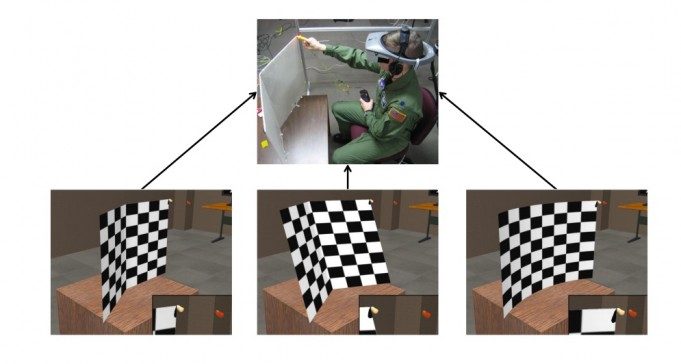 Redirected walking is a concept within VR that tricks a user into walking into circles, but gives them visual feedback that they’re walking in a straight line. We tend to trust our visual input over our other senses, and so redirected touch using that same principle of visual dominance in order to trick our minds into thinking it’s touching different objects while only using a single passive haptic object. It can also fool us into thinking that straight surfaces feel like curved surfaces.
Redirected walking is a concept within VR that tricks a user into walking into circles, but gives them visual feedback that they’re walking in a straight line. We tend to trust our visual input over our other senses, and so redirected touch using that same principle of visual dominance in order to trick our minds into thinking it’s touching different objects while only using a single passive haptic object. It can also fool us into thinking that straight surfaces feel like curved surfaces.
Luv Kohli is one of the pioneers of redirected touch, and he wrote his Ph.D. thesis on the topic at the University of North Carolina at Chapel Hill in 2013. I had a chance to catch up with Luv at the IEEE VR conference to learn more about the extent that we can warp VR spaces without our minds being able to consciously perceive it beyond having it temporarily feel weird.
LISTEN TO THE VOICES OF VR PODCAST
Here’s a video example of redirected touch where the user is touching a square object, but the user perceives that they’re touching a curved object because the visual field is so dominant.
There’s a number of interesting neuroscience of perception articles that I’ve come across over the last week that are related to this concept of hacking the limitations of our perception within VR.
- Donald D. Hoffman claims that the world presented to us by our perceptions is nothing like reality.
- Michael Herzog and Frank Scharnowski theorize that our brain processes conscious thoughts within time slices of 400ms “percepts.”
- And David Eagleman wrote an extended essay about Brain Time as it relates to time dilation and time contraction.
Reading through these articles brings up some fundamental questions about the nature of reality, and the takeaway for me is that there’s some low-level aspects of our reality that our brains may be perceiving, but that our perceptual system has perhaps evolved over time to only really process and understand signals in our system that would be essential for survival. We create high-level metaphors to comprehend what’s happening in the world around us, and it in a sense creates a very compelling illusion about the nature of reality.
VR is an illusion. But, you know, so is RR. h/t @kentbye https://t.co/84lxqYY5JN pic.twitter.com/11TFSKjTkG
— Beau Cronin (@beaucronin) April 27, 2016
Cognitive science and neuroscientists have been coming to these conclusions over the past number of years, and virtual reality is starting to bring more attention and awareness to the extent of our perceptual limitations. We’re building entirely virtual environments that have the ability to fool our minds into believing that we’re being transported into another world because of the magic of presence and what Mel Slater refers to as the place illusion and plausibility illusion that virtual reality provides.
Overall, VR is bringing awareness to some of these deeper philosophical questions about the nature of reality into question. The truth may be out there, but perhaps our conscious minds don’t really need to be bothered by the specifics of these details in order to survive. But as virtual reality content creators, knowing about the limitations of our perceptual capabilities allows us to use techniques like redirected walking and redirected touch to create realities that provide a deeper sense of embodied presence.
Become a Patron! Support The Voices of VR Podcast Patreon
Theme music: “Fatality” by Tigoolio







